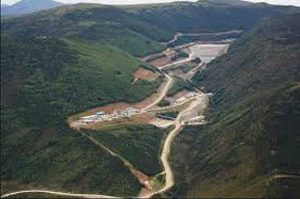
(Delta Junction) — The fatal mauling of a Pogo Mine contract employee by a black bear on Monday, June 19, remains under investigation by the Alaska Department of Fish and Game. Early reports suggested the attack showed signs of being predatory, but biologists say further examination of events and the bear involved is needed before a definitive conclusion can be reached.
Two Pogo Mine employees 27-year-old Erin Johnson of Anchorage, and 38-year-old Ellen Trainor of Fairbanks, were reported attacked by the bear, one, Johnson, mauled fatally, late Monday morning. The surviving employee was rescued by a mine helicopter after calling for help on a radio. Interviews after the incident indicate the bear broke off a subsequent attack on the survivor when the survivor deployed bear spray. The bear was subsequently killed by a mine employee who returned with a rifle. A department veterinarian who accompanied Alaska Wildlife Troopers to the scene to recover the bear carcass identified it as a cinnamon color-phase adult male. A necropsy has been performed on the bear and analysis is pending.
News of two people mauled and killed by black bears in separate incidents on successive days in separate regions of the state has many Alaskans on edge. The first attack occurred Sunday during a popular running event near Bird Creek south of Anchorage. The bear believed responsible for that attack was killed by department staff on Tuesday.[xyz-ihs snippet=”adsense-body-ad”]Wildlife managers generally divide bear attacks on humans into defensive and non-defensive (which includes predatory) categories. While bear attacks of any kind are relatively uncommon, predatory attacks on humans are rare. Of 207 bear attacks on humans recorded between 1980 and 2014 in Alaska, three were categorized as fatal predatory black bear attacks, according to retired state wildlife biologist John Hechtel.
Ranging from Florida and Texas north to the Brooks Range, black bears are North America’s most common bear species. Alaska’s black bear population is estimated to be at least 100,000. Black bear hunting is allowed in the Pogo Mine and Bird Ridge areas.
Bears may approach people out of curiosity, to test dominance, because they are food-conditioned or, rarely, because they are predatory. Interagency bear safety experts recommend people hiking, running or biking through bear country to carry a deterrent such as bear spray, or a firearm adequate for killing a bear. It is critical the deterrent be immediately within reach, where it can be quickly and easily accessed in the event of a sudden encounter.
When a bear is encountered at close range, people are advised to stand their ground, ready their deterrents, group up, and watch the bear. Stay firm and talk to the bear in a firm but calm voice. Don’t play dead, run, or panic. If blocking the bear’s path, try to move out of its way. If the bear continues to approach, follows, or is intent on a person, assert your dominance and become more aggressive. Don’t retreat. Shout, make yourself look large, use your deterrent or, if you don’t have a deterrent, throw rocks or sticks in an effort to drive off the bear. If the bear attacks, fight with anything you have, concentrating on the animal’s face or muzzle.
For more detailed information on how to respond in a bear encounter, visit https://www.adfg.alaska.gov/index.cfm?adfg=livingwithbears.bearcountry.
